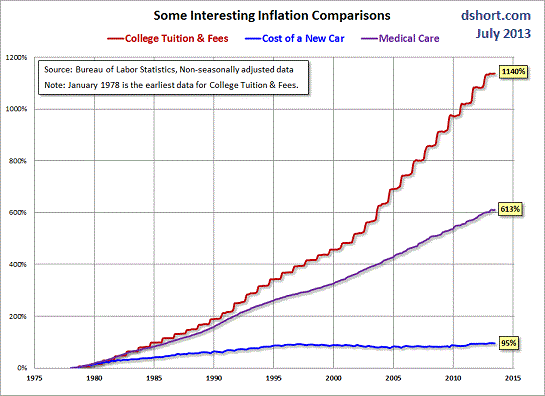Tuition costs skyrocketing is not a conspiracy. That's reality brought on by government interference in that market. Just like it did for housing 10-15 years ago. The govt inserted itself into housing. It pried and forced its way in and the result was a huge bubble. Same goes for health care. Govt enforced monopolization has eliminated competition which has allowed prices to soar. You literally cant open a clinic to do heart surgeries for $3000 in this country. You can elsewhere. But not here. So the costs are purely artificially inflated. You cant pay $36 for a shot of antivenom here, but you can pay that price in some other country,
even if it was manufactured here. That is blatant criminal cartel activity. If you were to do these things in the private sector, you would be prosecuted and imprisoned. That is not a conspiracy. None of the govt malfeasance is counted amongst the basket of goods used to calculate CPI. That's jsut a fact. You can go down the list.
None of this makes mint.com more accurate than the CPI. But we do know for a fact that the CPI is blatantly inaccurate.
To get the most accurate number you have to take all the spending of the median household, then adjust that by some sort of energy proxy deflator. Take total electricity consumption per capita as an example. Since total electricity consumption per capita has been flatlined, this is actually deflationary. So there are strong deflationary forces at work on the economy, against a backdrop of rampant money and credit creation for the extreme wealthy. All known reputable measures of inflation do not separate these two disparate forces. That's a big part of why the middle class continues to get screwed. The real paradigm continues to be obfuscated.

When they calculate the CPI what they are doing is wholly or partially eliminating lines like that red line in the chart above, using any manner of gaming they can think of. They can literally do whatever they want. There is nothing moral or rational about their methodology. Say when you go to college you might buy a dozen books. Some rapidly rise in price every year, others are the same price every year. They can easily choose only the books that do not rise in price and completely ignore the books that are rising in price. That's what they do. Same goes for fees that are counted amongst the cPI. Some fees rise every year. Others you know stay the same for years. They choose which ones they put in the CPI. There is not 3rd party of people's advocate that makes these decisions. The decisions are purely in the interest of those in the administration. Like with public unions there is no adversarial process to check and balance any of what goes on in the BLS.



